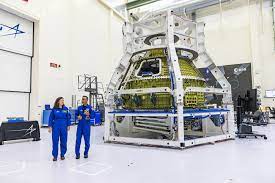
In a significant setback for NASA’s ambitious plans to return humans to the lunar surface, the much-anticipated Artemis mission has been postponed until September 2026. This delay, announced by the space agency on Tuesday, is attributed to mounting technical hurdles encountered by both NASA and its commercial partners involved in the Artemis program.
Originally slated for a late 2025 launch, the first lunar landing mission, Artemis III, has been pushed back by approximately a year. Alongside this delay, the precursor mission, designed to propel humans into deep space and orbit the moon for the first time in over five decades, is also facing a setback, now rescheduled for September 2025 instead of the initial target in November 2024.
The challenges faced by NASA and its collaborators, including Elon Musk’s SpaceX and Jeff Bezos’ Blue Origin, are indicative of the complexities inherent in executing such a groundbreaking mission. Jim Free, NASA’s associate administrator, acknowledged the spectrum of issues complicating the project during a news conference, citing technical problems with Lockheed’s Orion capsule, the designated vehicle for transporting astronauts to deep space.
Following an evaluation of data from Orion’s flight during the Artemis I mission, engineers identified concerns with the spacecraft’s heat shield and various internal components. Additionally, Free highlighted difficulties in developing new spacesuits and referenced challenges with Musk’s Starship rocket, which relies on an unprecedented technique involving propellant transfer between spacecraft in orbit.
A critical aspect of the Artemis mission involves SpaceX’s Starship, which necessitates multiple refueling operations in orbit to reach the moon. However, as SpaceX has yet to conduct a successful orbital flight of Starship, testing the vehicle’s capability to transfer propellant while in space remains pending. Jessica Jensen, SpaceX’s vice president of customer operations and integration, indicated that approximately “ten-ish” Starship launches might be required to fuel a mission to the moon.
Looking ahead, SpaceX anticipates securing a Federal Aviation Administration license to proceed with its third Starship test launch in February, marking a pivotal step in validating the spacecraft’s capabilities.
Despite the setback, NASA maintains that the fall 2026 timeframe for Artemis III remains “very aggressive,” underscoring the complexity and intricacies inherent in orchestrating a return to the lunar surface after more than half a century.
The delay underscores the formidable challenges of reconciling ambitious timelines with the realities of technical intricacies and the collaborative efforts between governmental space agencies and private entities, underscoring the complexities inherent in pushing the boundaries of space exploration.
Sources By Agencies


